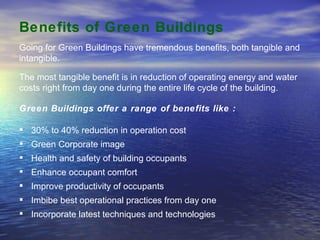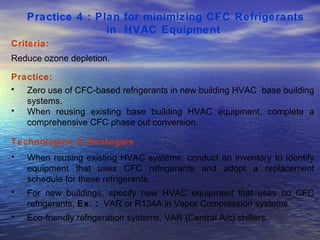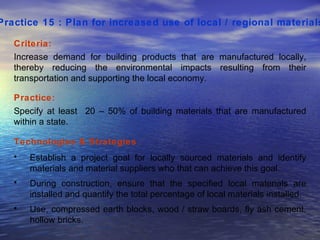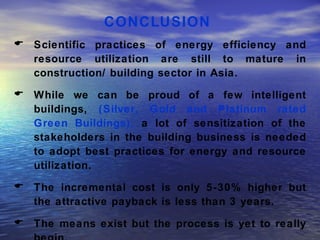Energy efficiency in buildings
- 1. Energy Efficiency in Buildings D PAWAN KUMAR
- 2. In current times of rapid infrastructure growth and looming energy crisis, there is a strong need to address and incorporate good practices for efficient energy and resource use while planning for buildings, be it for residential purpose or for commercial applications. Some such good practices are presented in the following discussion.
- 3. What is a Green Building? A Green Building is one which incorporates several Green features, such as: Use of Energy Efficient and Eco-Friendly Equipment Use of Recycled and Environmental Friendly Building Materials Quality Indoor air for human safety and comfort Use of Renewable Energy Effective Controls and Building Management System Efficient use of water Use of Non-Toxic & Recycled Materials Effective use of existing Landscapes Adoption of Cost effective and environment friendly technologies Green buildings would squarely address ecological and environmental impacts in a holistic manner and at the same time offer tremendous economic benefits to the occupants.
- 4. Benefits of Green Buildings Green Buildings offer a range of benefits like : 30% to 40% reduction in operation cost Green Corporate image Health and safety of building occupants Enhance occupant comfort Improve productivity of occupants Imbibe best operational practices from day one Incorporate latest techniques and technologies Going for Green Buildings have tremendous benefits, both tangible and intangible. The most tangible benefit is in reduction of operating energy and water costs right from day one during the entire life cycle of the building.
- 5. Typical Features of Green Buildings Adopting erosion Control techniques like temporary seeding, permanent seeding and mulching Encouraging occupants to use mass transportation like bus or rail, use of bicycles and use of cleaner fuels for automobiles Reduction of building footprints to minimize the impact on environment Reduction of impervious areas to prevent storm water run-off Installation of high efficiency irrigation methods and and selection of vegetation which have low water consumption Use of low water plumbing installations Harvesting of site energy CFC-free HVAC equipment Energy efficient equipment for air-conditioning and lighting systems Use of on-site renewable energy
- 6. Measurement & Verification plan to ensure energy and water savings Controls and Building Management systems Segregation collection and disposal of waste streams at source Use of salvaged or refurbished materials from other sites Recycling of construction debris to other sites Use of building materials having a high recycled content Use of rapidly renewable materials (material which could be replenished within a life cycle of 10 years) Declaration of the site as “Non-smoking” area or have designated areas for smoking Maintaining indoor environmental quality to avoid sick building syndrome Use of low VOC (volatile organic compound) paints, sealants and adhesives Typical Features of Green Buildings - Contd……
- 8. Practice 1 : Plan for minimum energy requirements: Criteria: Establish the minimum level of energy efficiency for the base building and systems. Practice: Design to meet building energy efficiency and performance as required by ASHRAE/IESNA 90.1-1999 or the local energy code, whichever is the more stringent. Technologies & Strategies : Design the building envelope and building systems to maximize energy performance. Use a computer simulation model to assess the energy performance and identify the most cost effective energy efficiency measures. Quantify energy performance as compared to a baseline building. Have an energy audit performed for the facility regularly
- 9. ILLUSTRATIVE ENERGY SCENE IN TYPICAL OFFICE COMPLEXES No. of floors 5 12 17 Floor area (SQM) 14088 26248 19150 Units / SQM (Summer) 15.40 14.3 15.67 Units / SQM (Winter) refrigeration TR (installed) 8.87 8.61 7.83 Overall TR / SQM 0.06 0.055 0.04 Installed TR / SQM 0.05 0.041 0.032 Refrigeration kW/TR 1.16 1.25 2.0 COP 3.03 2.81 1.76 Chiller effectiveness 23% 25% 23% Condenser effectiveness 41% 32.3% 37% Lighting points / SQ.M floor area 0.13 0.17 0.23 Lighting load Watts / SQM 13.85 13.77 8.14 Water pumping (total) watts / SQM floor area (height related) 1.42 1.79 4.43 Lifting load watts / SQM floor area (height & Cap. Related) 6.67 7.24 10.23 Total connected load Watts / SQM 126.7 121.9 136.32
- 10. Practice 2 : Optimize Energy Performance Criteria: Achieve increasing levels of energy performance above the pre-requisite standard to reduce environmental impacts associated with excessive energy use. Practice: Reduce design energy cost compared to the energy cost budget for regulated energy components described in the requirements of ASHRAE/IESNA Standard 90.1-1999, as demonstrated by a whole building simulation using the Energy Cost Budget Method Regulated energy components include HVAC systems, building envelope, service hot water systems, lighting and other regulated systems as defined by ASHRAE. Reduce design energy cost by 10 – 60%
- 11. Technologies & Strategies : Have an energy audit conducted for the building / facility Design the building envelope and building systems to maximize energy performance. Use a computer simulation model to assess the energy performance and identify the most cost effective energy efficiency measures. Quantify energy performance as compared to a baseline building. North light roofing, transparent roof sheets, ventilation design, chimney effect through tower design, aerated concrete block / hollow bricks, high ceiling, roof cooling salts.
- 12. Practice 3 : Plan for increasing levels of Renewable Technology use Criteria: Encourage and recognize increasing levels of self-supply through renewable technologies to reduce environmental impacts associated with fossil fuel energy use. Practice: Supply a net fraction of the building’s total energy use (as expressed as a fraction of annual energy cost) through the use of on-site renewable energy systems. Target % Total Energy Load Cost in Renewables between 5% to 20%. Technologies & Strategies : Assess the project for renewable energy potential including solar, wind, geothermal, biomass, hydro, and bio-gas strategies. When applying these strategies, take advantage of net information and Institutions local and international. Solar PV, CFL Solar hot water systems, solar cookers, bio-gas plants (rural segment), vermin composting.
- 13. Practice 4 : Plan for minimizing CFC Refrigerants in HVAC Equipment Criteria: Reduce ozone depletion. Practice: Zero use of CFC-based refrigerants in new building HVAC base building systems. When reusing existing base building HVAC equipment, complete a comprehensive CFC phase out conversion. Technologies & Strategies : When reusing existing HVAC systems, conduct an inventory to identify equipment that uses CFC refrigerants and adopt a replacement schedule for these refrigerants. For new buildings, specify new HVAC equipment that uses no CFC refrigerants, Ex. : VAR or R134A in Vapor Compression systems. Eco-friendly refrigeration systems, VAR (Central A/c) chillers.
- 14. Practice 5 : Plan for minimizing Ozone Depletion Criteria: Reduce ozone depletion and support early compliance with the Montreal Protocol. Practice: Install base building level HVAC and refrigeration equipment and fire suppression systems that do not contain HCFC’s or Halons. Technologies & Strategies : When reusing buildings, replace inventory of refrigerants and fire suppression chemicals in existing building systems with those that contain HCFCs or halons. For new buildings, specify refrigeration and fire suppression systems that use no HCFCs or halons.
- 15. Practice 6 : Plan for easy accounting of energy & water consumption Criteria: Provide for the ongoing accountability and optimization of building energy and water consumption performance over time. Practice: Plan with the long term continuous measurement of performance : Lighting systems and controls Constant and variable motor loads Variable frequency drive (VFD) operation Chiller efficiency at variable loads (kW/ton) Cooling load Air and water economizer and heat recovery cycles Air distribution static pressures and ventilation air volumes Boiler efficiencies Building specific process energy efficiency systems and equipment Indoor water risers and outdoor irrigation systems
- 16. Some Illustrative Norms : Lighting 8 Watts / M 2 Air Conditioning 0.15 TR / M 2 U-value of roof 0.63 Btu / hr/sq ft /deg F with R-15 insulation U-Value of wall 0.58 Btu / hr./sq ft/deg F. COP of chillers 4.23 and above
- 17. Fly ash based cement for use Fly ash based Aerocon blocks Declaration of building as ‘non-smoking’ CO 2 censor installation Regular checks on AHU filters Use of composite wood Day light view for 90 % occupied areas Minimum 25 % open space apart from built-up area Site location close to Bus and Rail lines Some more Good Practices – put to action
- 18. Access to community transport rather than individual transportation Extensive roof garden coverage Rain water harvesting Drip irrigation Fast growing plantations Use of low ‘U’ glass glazing Day-light dimmer controls Some more Good Practices – put to action Contd…
- 19. Technologies & Strategies : Through building energy audit, model the energy and water systems to predict savings. Design the building with equipment to measure energy and water performance. Draft a Measurement & Verification Plan to apply during building operation that compares predicted savings to those actually achieved in the field.
- 20. Practice 7 : Plan for Water efficient Landscaping Criteria: Limit or eliminate the use of potable water for landscape irrigation. Practice: Use high efficiency irrigation technology, OR, Use captured rain or recycled site water, to reduce potable water consumption for irrigation over conventional means. Technologies & Strategies : Perform a soil / climate analysis to determine appropriate landscape types and Design the landscape with indigenous plants to reduce or eliminate irrigation requirements. Use high efficiency irrigation systems and consider reuse of storm water volumes for irrigation. Adopt ISO:14000 certification for large facilities. Pervious paver blocks, roof cover with gardens, rain water harvesting.
- 21. Practice 8 : Plan for maximizing Wastewater reuse and less dependence on municipal water source Criteria: Reduce the generation of wastewater and potable water demand, while increasing the local aquifer recharge. Practice: Reduce the use of municipally provided potable water for building sewage conveyance OR Treat all of wastewater on site for re-use application. Technologies & Strategies : Estimate the wastewater volumes generated in the building and specify high efficiency fixtures and dry fixtures such as composting toilets and waterless urinals to reduce these volumes. Consider reusing storm water for sewage conveyance or on-site wastewater treatment systems (mechanical or natural). Biological root zone treatment Recycled water for gardening Sewage water for mechanical (filter press drum) type cleaning systems etc.
- 22. Practice 9 : Plan for maximizing Water Use efficiency Criteria: Maximize water efficiency within buildings to reduce the burden on municipal water supply and wastewater systems. Practice: Employ strategies that in aggregate use less water than the water use baseline calculated for the building (not including irrigation). Reduce the potable water use reduction by at least 10%. Technologies & Strategies : Estimate the potable and non-potable water needs for the building. Use high efficiency fixtures, dry fixtures such as composting toilets and waterless urinals, and occupant sensors to reduce the potable water demand. Consider reuse of storm water for non-potable applications such as toilet and urinal flushing, mechanical systems, and custodial uses.
- 23. Practice 10 : Plan for Storage & Collection of Recyclables while building Criteria: Facilitate the reduction of waste generated by building occupants that is hauled to and disposed of in landfills. Practice: Provide an easily accessible area that serves the entire building and is dedicated to the separation, collection and storage of materials for recycling including (at a minimum) paper, glass, plastics, and metals. Technologies & Strategies : Designate an area for recyclable collection and storage that is appropriately sized and located in a convenient area. Identify local waste handlers and buyers for glass, plastic, office paper, newspaper, cardboard, and organic wastes. Instruct occupants on building recycling procedures. Consider employing cardboard balers, aluminum can crushers, recycling chutes, and other waste management technologies to further enhance the recycling program. Recycled wood, glass, aluminum and ceramic tiles, furniture made of bagasse based completed wood, etc.
- 24. Practice 11 : Plan for building life extension and re-use Criteria: Extend the life cycle of existing building stock Conserve resources Retain cultural resources Reduce waste Reduce environmental impacts of new buildings as they relate to materials manufacturing and transport. Practice: Reuse large portions of existing structures during renovation or redevelopment projects Identify opportunities to incorporate salvage materials such as beams and posts, flooring, paneling doors, frames, cabinets, furniture, bricks and decorative items.
- 25. Technologies & Strategies : Consider reuse of existing buildings, including structure, shell, and non-shell elements. Remove elements that pose contamination risk to building occupants and upgrade outdated components such as windows, mechanical systems, and plumbing fixtures.
- 26. Practice 13 : Plan for increasing ventilation effectiveness Criteria: Provide for the effective delivery and mixing of fresh air to support the health, safety, and comfort of building occupants. Practice: For mechanically ventilated buildings, design ventilation systems that result in an air change effectiveness (E) greater than or equal to 0.9 as determined by ASHRAE 129-1997. For naturally ventilated spaces demonstrate a distribution and laminar flow pattern that involves not less than 90% of the room or zone area in the direction of air flow.
- 27. Technologies & Strategies : Design the HVAC system and building envelope to optimize air change effectiveness. Air change effectiveness can be optimized using a variety of ventilation strategies including displacement ventilation, low-velocity ventilation, and operable windows. The air change effectiveness of the building after construction should be regularly tested. CO 2 monitoring, chimney type ducting for intake / exhaust.
- 28. Practice 14 : Plan for minimum indoor air quality requirement Criteria: Establish minimum indoor air quality (IAQ) performance to prevent the development of indoor air quality problems in buildings, maintaining the health and well being of the occupants. Practice: Meet the minimum requirements of voluntary consensus standard ASHRAE 62-1999, Ventilation for Acceptable Indoor Air Quality and approved Addenda. Technologies & Strategies : Design the HVAC system to meet the ventilation requirements of the reference standard. Identify potential IAQ problems on the site and locate air intakes away from contaminant sources like ; Low volatile organic matter paints, carpets, adhesives, sealants.
- 29. Practice 15 : Plan for increased use of local / regional materials Criteria: Increase demand for building products that are manufactured locally, thereby reducing the environmental impacts resulting from their transportation and supporting the local economy. Practice: Specify at least 20 – 50% of building materials that are manufactured within a state. Technologies & Strategies : Establish a project goal for locally sourced materials and identify materials and material suppliers who that can achieve this goal. During construction, ensure that the specified local materials are installed and quantify the total percentage of local materials installed. Use, compressed earth blocks, wood / straw boards, fly ash cement, hollow bricks.
- 30. Practice 16 : Plan for efficient and safe wiring practices Criteria: Quality assurance of electrical wiring material, wiring accessories, earthing, leakage protection, over load protection devices and metering to ensure safe and energy efficient distribution infra-structure. Practice: Adopt well established standard material and engineering practices. Technologies & Strategies : MCCB’s, / MCBs, CVT’s, UPS, Electronic Ballasts, CFLs, remote controls for lights and fans, electronic regulators, earth leakage protection relays and occupancy sensors are some of the devices and technologies applicable in this context.
- 31. CONCLUSION Scientific practices of energy efficiency and resource utilization are still to mature in construction/ building sector in Asia. While we can be proud of a few intelligent buildings, (Silver, Gold and Platinum rated Green Buildings), a lot of sensitization of the stakeholders in the building business is needed to adopt best practices for energy and resource utilization. The incremental cost is only 5-30% higher but the attractive payback is less than 3 years. The means exist but the process is yet to really begin.
- 32. THANK YOU































